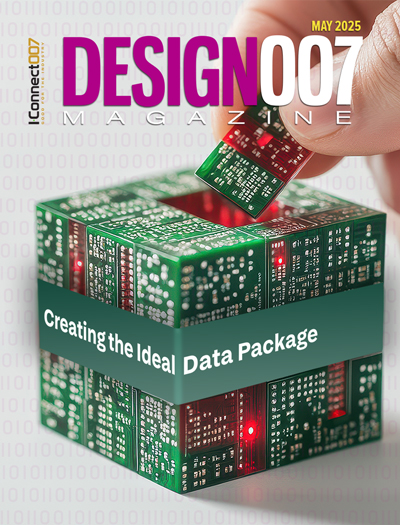-

- News
- Books
Featured Books
- design007 Magazine
Latest Issues
Current Issue
Creating the Ideal Data Package
Why is it so difficult to create the ideal data package? Many of these simple errors can be alleviated by paying attention to detail—and knowing what issues to look out for. So, this month, our experts weigh in on the best practices for creating the ideal design data package for your design.

Designing Through the Noise
Our experts discuss the constantly evolving world of RF design, including the many tradeoffs, material considerations, and design tips and techniques that designers and design engineers need to know to succeed in this high-frequency realm.

Learning to Speak ‘Fab’
Our expert contributors clear up many of the miscommunication problems between PCB designers and their fab and assembly stakeholders. As you will see, a little extra planning early in the design cycle can go a long way toward maintaining open lines of communication with the fab and assembly folks.
- Articles
- Columns
Search Console
- Links
- Media kit
||| MENU - design007 Magazine
Beyond Design: Plane Crazy, Part 2
February 8, 2016 | Barry Olney, In-Circuit DesignEstimated reading time: 1 minute
In my recent four-part series on stackup planning, I described the best configurations for various stackup requirements. But I did not have the opportunity to delve into the use of planar capacitance to reduce AC impedance at frequencies above 1GHz, which is the region wherein bypass and decoupling capacitors dramatically lose their impact. In this column, I will flesh out this topic, and consider the effects of plane resonance on the power distribution network (PDN).
Figure 1 illustrates a 12-layer DDR3 board with six routing layers and six plane layers utilizing multiple technologies. This board must accommodate 40/80-ohm single-ended/differential impedance for DDR3, 90-ohm differential USB, and the standard 50/100-ohm digital impedances all on the same substrate. In order to reduce the layer count, it is important that these different technologies share the same layers. Plus, one needs to manage the return current paths and broadside coupling of the stripline configurations—quite a challenge!
The DDR3 matched delay signals are routed on the internal layers 3 & 4 and 9 & 10, which all use ground (GND) as the reference plane. To eliminate broadside coupling, the data lanes (eight in this case), differential strobes, and masks are routed on layers 3 & 4. And the adjacent traces are routed skewed or orthogonally. The address, control and command signals are routed together with the differential clock on layers 9 & 10. This separates the data lanes and address signals. Since DDR technology utilizes synchronous buses, the signals within the data lanes and within the address bus can be routed closely together, but the eight data lanes should be separated to avoid crosstalk.
As you can see, there are four planes in the center of the board, two power and two ground. This is where tight coupling, between adjacent planes, can be utilized to add planar capacitance at low cost and dramatically reduce the AC impedance at the high end. There are thin sheets of Isola 370HR 1080 prepreg (2.8 mils thick) between both planes pairs.
Given the effects of the capacitors equivalent series inductance (ESL) and mounting inductance, the added planar capacitance still reduces the overall impedance to approximately the target impedance up to 1GHz as in Figure 2. Now, this is not easy to do using standard stackups.
To read this entire article, which appeared in the January 2015 issue of The PCB Design Magazine, click here.
Suggested Items
The Shaughnessy Report: Solving the Data Package Puzzle
05/12/2025 | Andy Shaughnessy -- Column: The Shaughnessy ReportIf you ask fabricators about their biggest challenges, they’ll often point at PCB designers—the readers of this magazine. Yes, you! Why is it so difficult to create the ideal data package? It’s a fairly straightforward task. But this part of the design process keeps tripping up designers, even those who started in the industry before Pink Floyd split up.
AI Chips for the Data Center and Cloud Market Will Exceed US$400 Billion by 2030
05/09/2025 | IDTechExBy 2030, the new report "AI Chips for Data Centers and Cloud 2025-2035: Technologies, Market, Forecasts" from market intelligence firm IDTechEx forecasts that the deployment of AI data centers, commercialization of AI, and the increasing performance requirements from large AI models will perpetuate the already soaring market size of AI chips to over US$400 billion.
ZenaTech’s ZenaDrone Tests Proprietary Camera Enabling IQ Nano Drone Swarms for US Defense Applications, Blue UAS Submission
05/09/2025 | Globe NewswireZenaTech, Inc., a technology company specializing in AI (Artificial Intelligence) drones, Drone as a Service (DaaS), enterprise SaaS, and Quantum Computing solutions, announces that its subsidiary ZenaDrone is testing a new proprietary specialized camera that enables more efficient indoor applications such as inventory and security management, when utilizing IQ Nano drone swarms for commercial and US defense applications.
New Issue of Design007 Magazine: Are Your Data Packages Less Than Ideal?
05/09/2025 | I-Connect007 Editorial TeamWhy is it so difficult to create the ideal data package? Many of these simple errors can be alleviated by paying attention to detail—and knowing what issues to look out for. So, this month, our experts weigh in on the best practices for creating the ideal data package for your design.
Cadence Unveils Millennium M2000 Supercomputer with NVIDIA Blackwell Systems
05/08/2025 | Cadence Design SystemsAt its annual flagship user event, CadenceLIVE Silicon Valley 2025, Cadence announced a major expansion of its Cadence® Millennium™ Enterprise Platform with the introduction of the new Millennium M2000 Supercomputer featuring NVIDIA Blackwell systems, which delivers AI-accelerated simulation at unprecedented speed and scale across engineering and drug design workloads.


